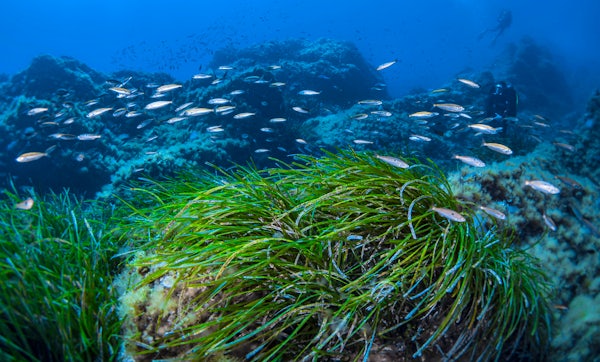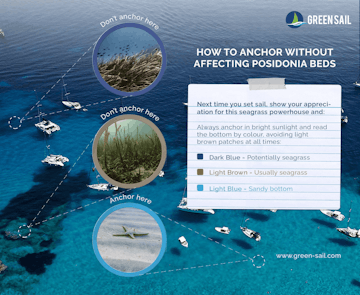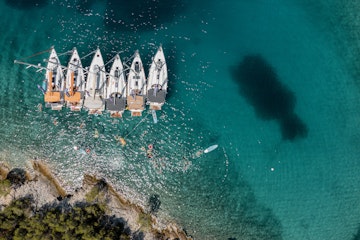Blogs 
5 minute read
Last updated
24th Jul 2025
Protecting Mediterranean Seagrass: Why Smart Anchoring Means Avoiding Dark Seafloors

The Mediterranean Sea harbours some of the world's most important marine ecosystems, with vast underwater meadows that serve as the ocean's lungs, nurseries, and carbon storage systems. For responsible sailors and boaters, understanding these critical habitats and how to avoid damaging them is essential for preserving the Mediterranean's marine heritage.
This animation is featured in our Sustainability for Skippers and Crew Management course. Gain the knowledge and tools to manage sustainability effectively in your maritime operations. This comprehensive course covers practical strategies to reduce your environmental impact.
The Golden Rule: Seek Sandy, Avoid Dark
When it comes to anchoring in the Mediterranean, the safest approach for both your vessel and the marine environment is simple: anchor on light, sandy bottoms and avoid dark seafloors altogether. This straightforward rule protects you from the uncertainty of distinguishing between different types of marine vegetation while ensuring you don't damage critical seagrass ecosystems.
Dark patches on the seafloor typically indicate the presence of seagrass meadows or algal communities - both of which play vital roles in marine ecosystems and should be avoided when anchoring. Light sandy areas, in contrast, provide excellent holding for your anchor while minimising environmental impact.
Understanding Posidonia oceanica: The Mediterranean's Underwater Forest
Posidonia meadows are engineering marvels of nature. They have a very high carbon absorption capacity and soak up to 15 times more carbon dioxide every year than a similarly sized piece of the Amazon rainforest.
Each plant grows from thick, rope-like rhizomes (horizontal root systems) that form dense mats across the seafloor. From these rhizomes emerge long, ribbon-like leaves that can reach 30-100 cm in length and 0.5-1.5 cm in width. These bright green blades create a three-dimensional underwater landscape that supports an extraordinary diversity of marine life. The plant's thick, layered root system not only anchors it firmly to the seabed but also traps sediments, preventing coastal erosion and maintaining water clarity. This natural engineering creates stable underwater meadows that can persist for millennia, with some beds estimated to be over 100,000 years old.
Beyond their impressive structure, these underwater meadows provide crucial environmental benefits. Posidonia meadows produce up to 20 litres of oxygen per square meter daily and provide vital habitat for over 400 marine species, from tiny invertebrates to larger predators. They protect coastlines from erosion by absorbing wave energy and serve as exceptional carbon storage systems, storing carbon at more than triple the rate of tropical rainforests. The meadows also act as natural water purifiers, trapping sediments and pollutants to maintain the Mediterranean's crystal-clear waters.

Visual Identification from the Surface
From your boat, Posidonia meadows appear as dark patches or bands on the seafloor, particularly visible in clear, shallow waters. The dense growth creates distinctive shadowing that contrasts sharply with the bright, uniform appearance of sandy bottoms. These dark areas may appear almost black in deeper water or show as deep green patches in shallower areas.
Along Mediterranean shorelines, you'll often encounter "banquettes" - large accumulations of washed-up Posidonia leaves that form natural barriers along beaches. Unlike algae, which decompose quickly, these fibrous leaves persist and accumulate, creating distinctive brown mats that are a sign of healthy offshore meadows.
Other Important Mediterranean Seagrasses
While Posidonia oceanica gets much attention, the Mediterranean is also home to other valuable seagrass species that deserve protection:
Cymodocea nodosa creates smaller, patchier meadows with narrower leaves than Posidonia. Though less dense, these meadows still provide crucial habitat for juvenile fish and invertebrates, particularly in shallower coastal areas.
Zostera marina and Zostera noltei form important seagrass communities, especially in coastal lagoons and sheltered bays. These grasses have thinner, more delicate leaves but create equally important nursery habitats.
All Mediterranean seagrasses share similar ecological functions - they produce oxygen, sequester carbon, stabilise sediments, and provide critical habitat for marine life. From an anchoring perspective, they all appear as darker patches on the seafloor and should be avoided equally.

Please note the dark patches of water visible in the image above, which indicate the presence of Posidonia meadows.
The Environmental Stakes
These seagrass ecosystems face unprecedented pressure from coastal development, pollution, and physical damage from anchoring and mooring. A single anchor drop can destroy decades or even centuries of growth, creating scars that take generations to heal - if they heal at all.
Posidonia meadows are among the most effective carbon-sequestering ecosystems on Earth, storing carbon at rates up to 35 times faster than tropical rainforests. They also produce significant amounts of oxygen and help maintain the crystal-clear waters that make the Mediterranean so appealing to boaters.
By following the simple rule of avoiding dark seafloors when anchoring, sailors and boaters become active participants in marine conservation. This straightforward approach eliminates the need to distinguish between different types of seagrass or marine vegetation while ensuring protection for all these critical ecosystems.
The Mediterranean's seagrass meadows represent thousands of years of natural growth and evolution. They are living libraries of biodiversity, climate regulators, and the foundation of the marine food web. By anchoring responsibly on sandy bottoms, we ensure that future generations can experience the same pristine Mediterranean waters that draw us to these magical seas today.
Smart anchoring isn't just about protecting the environment - it's about preserving the very qualities that make Mediterranean sailing so extraordinary. Clear waters, abundant marine life, and thriving coastal ecosystems all depend on the health of these underwater meadows. When we anchor responsibly, we're not just avoiding damage; we're actively contributing to the conservation of one of the world's most remarkable marine environments.

